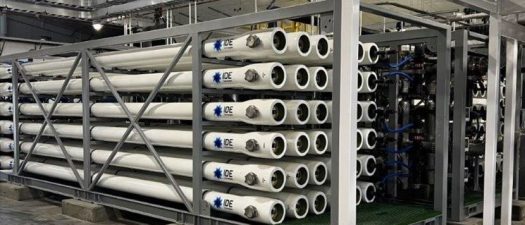Across industries, the move toward sustainability is no longer optional — it’s essential. .
Sustainable Solutions for Brine Disposal: The Hadera Desalination Project Redesign

As the demand for freshwater intensifies globally, desalination has become an essential technology for addressing water scarcity. However, the disposal of brine, the concentrated saline byproduct of desalination, poses a significant environmental challenge. The Hadera Desalination Plant in Israel, a critical part of the country’s water infrastructure, recently faced challenges related to its brine outfall discharge. IDE Technologies was tasked with redesigning the brine diffuser system to improve its environmental performance. This blog explores the innovative solution IDE implemented to overcome these challenges, resulting in enhanced brine dispersion, reduced environmental impact, and improved operational efficiency.
Background: The Hadera Desalination Plant and New Challenges
Since its inception in 2009, the Hadera Desalination Plant has been a cornerstone of Israel’s water supply, producing 137 million cubic meters of drinking water annually. Located adjacent to the Orot Rabin power station, the desalination plant initially relied on blending its brine with the power station’s cooling water before discharge into the Mediterranean Sea. However, the power station’s transition from coal to natural gas necessitated a change in the desalination plant’s brine disposal system.
In 2020, H2ID and the Water Desalination Administration of Israel (WDA) agreed on a solution that included an offshore tunnel and a new brine diffuser system to ensure compliance with environmental regulations. The plant’s brine diffuser design was initially developed by an international engineering firm, but upon review, IDE identified significant gaps and disadvantages in the design. This prompted a redesign effort in late 2023, incorporating IDE’s advanced simulation capabilities to optimize brine dispersion.
Leveraging In-House Simulation for Brine Diffuser Optimization
Typically, brine dispersion modeling is outsourced to external consultants, often resulting in delays or misalignments in the final design. To mitigate these risks, IDE Technologies made a strategic decision to build in-house computational fluid dynamics (CFD) capabilities. This investment, led by Dr. Eyal Price, Head of IDE’s Hydraulic Engineering Team, allowed the company to directly integrate simulation results into the design process and rapidly iterate on solutions.
Using CFD modeling, IDE created detailed 3D models of the brine diffuser and the surrounding sea environment. This enabled the team to visualize the dispersion of brine, optimize nozzle configuration, and assess the impact of variables such as brine density, temperature, and sea currents. CFD modeling proved to be a game-changer in understanding multi-plume interactions and site-specific dynamics, leading to a more reliable and environmentally responsible diffuser design.
Key Improvements in the Revised Diffuser Design
Nozzle Orientation: One of the key improvements in the revised design was the adjustment of nozzle orientations. The original design risked jet merging, which could lead to inefficient brine mixing. The new configuration ensures that the nozzles are directed in a way that prevents this risk, maximizing dilution efficiency.
Shortened Diffuser Structure: The length of the diffuser was reduced from 60 meters to 18 meters, significantly decreasing the marine construction footprint. This minimizes excavation and backfill requirements, decreasing environmental disturbance to the seabed and limiting the construction timeline.
Hydraulic Optimization: CFD modeling confirmed that the revised design meets the maximum allowable water levels in the brine pit, even at peak flow rates. This ensures that the facility operates without the risk of flooding, which could compromise onshore infrastructure and operations.
Environmental Benefits and Operational Efficiency
The revised brine diffuser design has yielded several key benefits, including:
Environmental benefits:
- Reduced Salinity Impact: The new diffuser achieves a lower salinity impact on the seabed, with excess salinity reduced to just 7.1% compared to the original design’s 9.8%. This improvement ensures compliance with environmental regulations and minimizes ecological risk.
- Lower Construction Impact: The shortened diffuser structure has reduced the environmental footprint of the construction process by approximately 20,000 m³, halving environmental disturbance to the seabed and shortening the construction timeline.
Contractual benefits:
- Schedule risk reduction: Less marine work means fewer weather-related delays and greater availability of construction equipment.
- Regulatory compliance: The design fully meets contractual requirements for maximum water level and environmental performance
Lessons Learned: The Importance of Early-Stage Simulation
The Hadera project highlights the importance of integrating CFD modeling and brine dispersion simulation early in the design process in order to identify potential risks, mitigate design challenges before construction, and ensure compliance with both regulatory and environmental standards.
A proactive approach helped IDE deliver a reliable, environmentally friendly solution while adhering to the project’s tight deadlines and budget constraints.
The Hadera project serves as a model for future desalination projects, demonstrating that early-stage simulation and in-house expertise can lead to more efficient, cost-effective, and environmentally responsible designs.
Conclusion: Setting a New Standard for Sustainable Desalination
IDE Technologies’ innovative redesign of the brine diffuser at the Hadera Desalination Plant sets a new benchmark for sustainable desalination infrastructure. By integrating advanced simulation tools, IDE has successfully optimized the brine disposal process. As desalination plants continue to grow in scale worldwide, the lessons learned from Hadera will play a key role in shaping the future of environmentally responsible water treatment solutions.
















